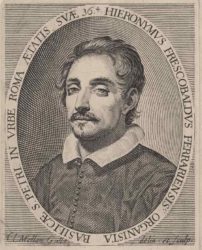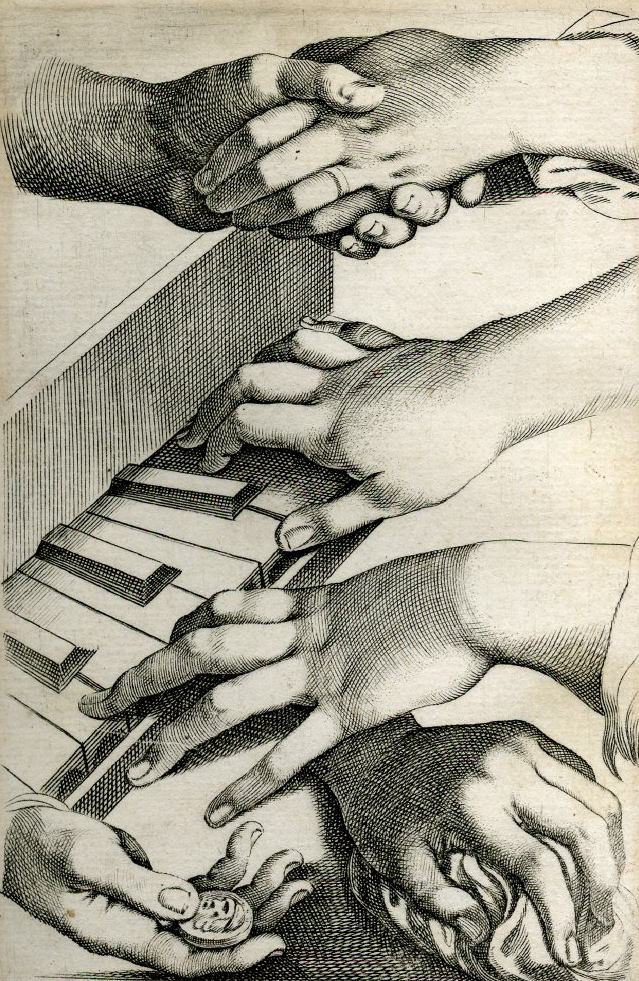Flora would sit alone in the little green parlor … reading in The Higher Common Sense of the Abbé Fausse-Maigre the chapter on ‘Preparing the Mind for the Twin Invasion by Prudence and Daring in Dealing with Substances not Included in the Outline.’
Stella Gibbons, Cold Comfort Farm
the difficulty … is not that of finding the solution but rather that of recognizing as the solution something that looks as if it were only a preliminary to it.
Ludwig Wittgenstein, Zettel 314
19.1 Frescobaldi may have been as Giovanni Battista Doni depicted him, an unlettered and uncultivated craftsman, skilled only in the composition and performance of keyboard music. Nonetheless, Girolamo’s observations on his own works echo the language and reflect the criteria of his more sophisticated contemporaries in poetry and the visual arts. The qualities of maniera (“style” in the abstract), novità (freshness or innovation), and meraviglia (surprise and delight without violence to tradition) mark Frescobaldi’s music and his statements about it as deeply as they mark the poetry of Marino, the architecture of Borromini, or anything from the hand of Bernini. Novelty of artifice, variety, grace, elegance, virtuoso display—and what terms could better describe the art of seventeenth-century Rome?—were cited explicitly by Frescobaldi as the hallmarks of the new style he created and bequeathed as a model to his successors.
19.2 Girolamo’s art was “at the ends of his fingers,” in Doni’s words, at least in the sense that his style was as much one of execution as of composition. Such personal styles were transmitted by direct contact between teacher and pupil, sometimes with little or no reference to a written score in the process. In 1615 Cesare Marotta offered a composition to Enzo Bentivoglio:[1]
… I am sending to Your Most Illustrious Lordship the [score of the] romanesca that you command me, although I have refrained from showing it [the written score] to Signora Francesca, so that you might hear it from her in the manner in which I desired it to be sung, since I always think that it is not easy to show it to someone who does not have the practice of it well; for although it is a romanesca, nonetheless I call it a bastard romanesca, since in many places it must be sung with affetto, and in others with vocal tenute, accenti [an ornament] and other attentions, which cannot be written but require the living voice [la viva voce].
19.3 Bernardo Bizzoni put it more succinctly: “it’s true that the Arias of Rome here succeed better in hearing them sung than in writing them down.”[2]
19.4 When such music that depended on its manner of execution for its full effect was addressed to performers outside the composer’s immediate circle some description of this style was necessary. Giulio Caccini, for example, felt his particular method of singing important enough to the understanding of his music to preface the Nuove musiche with an extensive introduction on performance. Frescobaldi was the first (and only) contemporary keyboard composer to follow suit in his own publications. The examination of Girolamo’s prefaces and their meaning, then, is an expansion of the performing text, only a portion of which is provided by the note-picture.
19.5 Frescobaldi’s directions for performance have not always been taken seriously. They have been cited frequently, but often out of context and with fundamental flaws in translation and interpretation. In any case, they must be considered not in isolation but in the larger context of musical practice in later sixteenth- and seventeenth-century Italy.[3]
19.6 Frescobaldi presented indications for performance in the prefatory material to four keyboard collections: the two versions of the first book of toccatas (cited as 1615, 1616), the Capricci (1624), and the Fiori musicali (1635). His pupil Bartolomeo Grassi’s epilogue to the keyboard version of the Canzoni (1628) also contains observations on performance (for texts and translations see Documentary Appendix III: Prefatory Material). For the purposes of discussion it will be assumed that these are expressions—admittedly fragmentary and sometimes inconsistent—of a basically coherent conception of performance, and that where seeming contradictions occur they are the products of differing contexts or interpretations: no one familiar with Girolamo’s letters could claim that he was an impeccable prose stylist.
19.7 For an understanding of the musical milieu in which Frescobaldi’s style developed there is a rich variety of sources. The treatises of Girolamo Diruta and Adriano Banchieri elucidate the basic principles of Italian keyboard technique, and further technical and interpretive information is scattered in the writings and music of Girolamo’s contemporaries, notably Costanzo Antegnati, Severo Bonini, Bernardino Bottazzi, Giovanni Battista Fasolo, Scipione Giovanni, André Maugars, Ascanio Mayone, and Giovanni Maria Trabaci. The background and context of solo keyboard music are illuminated by accounts of continuo practice (Agostino Agazzari, Emilio de’ Cavalieri, Ludovico Viadana), instrumental tutors, vocal and instrumental ornamentation manuals such as those of Giovanni Battista Bovicelli, Giovanni Luca Conforti, Giovanni Domenico Puliaschi, and Francesco Severi, and by the writings of the Florentine monodists. Ancillary evidence from outside Italy is provided in Tomás de Sancta Maria’s discussions of keyboard fingering, rhythm, and ornamentation, and in Michael Praetorius’ encyclopedic account of instruments and performance practice.[4]
19.8 This whole body of material must be brought to bear in examining the two kinds of questions that are the legitimate concerns of the study of performance. The first category is that of Aufführungspraxis in the strict sense: matters such as text and notation, instrumentation, and methods and conventions of performance, which can be examined on the basis of historical evidence. The second category surveys the broader field of interpretation and is concerned with such things as articulation, tempo, form, and expressive content. Contrary to a frequent assumption, answers to questions in the first category cannot necessarily be accepted as solutions to problems in the second; but the consideration of specific areas of performance practice can lead to more general observations about interpretation.
Tempo
19.9 In all four of Frescobaldi’s prefatory statements, matters of tempo predominate. “There is no doubt, that the perfection of playing consists principally in understanding the tempi” (1615); “… referring to the good taste and fine judgment of the player in the conduct of the tempo; in which consist the spirit and the perfection of this manner and style of playing” (1616); “… the playing of these works could result in great effort for some, seeing that they are of divers tempi & variations…” (1624); “In the Kyries some can be played with a lively beat & others with a slow one ….” (1635).
19.10 Tempo is determined by the speed of a battuta or regular beat, which in theory remained consistent: “But they [the partie] should be taken entire with the same tempo (1615).”[5] The tempo of a work or a section of a piece of music could be slow or fast, “lenta/larga” or “allegra/presta.” One factor in setting the speed of the beat was the complexity of the figuration: Bovicelli 1594: “….singing not in Chapel style, but in Concerto style, where the beat must be slow..”[6] Church music notated in minims in ¢ would have a relatively fast beat but slower motion, while concert music notated in C and employing smaller notes values would require a slower beat but would sound faster. This was summed up by Frescobaldi in discussing variations (partite):
In the [single] partite let a just and proportionate tempo be taken, and because in some [partite] there are rapid passages one should begin with a comfortable [commoda] beat, for it is not proper to begin rapidly and continue slowly…. (1615).
In the Partite when there will be found passaggi, and affetti it will be well to choose a broad [largo] tempo: which is to be observed also in the toccatas. The other [partite] not having passaggi can be played somewhat allegro in beat, referring the conduct of the tempo to the good taste and fine judgment of the player; in which consist the spirit and the perfection of this manner and the style of playing (1616).
19.11 Frescobaldi and others noted that the overall beat could be inflected according to the affetto of a passage:
First: that this manner of playing [toccatas] must not remain subject to a beat, as we see practiced in modern Madrigals, which although difficult are facilitated by means of the beat taking it now slowly, now rapidly, and even suspending it in the air, according to their affetti, or meaning of the words (1616).
19.12 Puliaschi 1618: …. using beats of various tempos between the serious arie, & and the happy [allegre] ones, as in some sections even accelerating [the beat] & retarding it…[7]
In the Toccatas when you find some trills, or affettuoso passages play them adagio and in the eighths follow in the parts together to make them somewhat allegro and in the trills let them be taken more adagio slowing the beat although the toccatas must be played at the pleasure of the player according to his taste (1635).
19.13 The beat was often broadened at the end of a section: Giovanni Maria Trabaci (1603, 1615) frequently indicates “allarga la battuta,” “broaden the beat.”[8] Frescobaldi 1616: “… in approaching the concluding of the passages or cadence one will go on drawing out the tempo more slowly.”
19.14 In certain circumstances the beat could be manipulated proportionally like the Renaissance tactus. The most frequent of these proportions were the triplet subdivisions 6/4 (from 4/4) and 12/8 (from 8/8) and ternary proportions such as 2/2 = 3/2 or 3/1 (see below). Trabaci employs the indication “In Battuta stretta” in the verses on the eight church modes of his Secondo Libro (1615).[9] In every case the direction qualifies a verset in ¢ moving in halves and quarter subdivisions (III, last verset; IV, verset 2; V, v. 1; VI, v.2; VIII, vv.5, 10) and thus implies a faster beat. (The signature ¢ originally indicated halving the tactus in C.) The ottava (1615: settima) parte of Frescobaldi’s Romanesca variations displays the same characteristics: a unique ¢ signature and a half-note beat with quarter and eighth subdivisions.
19.15 Frescobaldi and his contemporaries employed few tempo indications: adagio, allegro, and an occasional presto. Specific tempo markings do not occur in Frescobaldi’s instrumental works until relatively late in his career, with the “adagio” and “alegro” of the 1628 ensemble canzonas and the 1635 Fiori musicali. As in their infrequent appearance elsewhere in the music of this period, these terms seem to indicate a deviation from and return to a general moderate tempo. Sections marked adagio occur within the instrumental canzonas and can be implied at the beginning by a subsequent allegro. Adagios are always in C, allegros (sometimes “presto”) can be in C or some (proportional) triple meter. In the instrumental canzonas and the Fiori musicali adagio sections often serve as cadential pivots between two allegro sections, and the similar unmarked sections in the earlier keyboard toccatas would presumably be performed in the same way. The juxtaposition of adagio and allegro indicates that the two terms refer to contrasting tempos, slow and faster.
19.16 But “adagio,” even more clearly in the form of “ad aggio,” “at ease,” seems also to connote a freer, quasi-improvisatory style of performance: Giovanni Luca Conforti, 1615: “although they [his passaggi] may be written in [strict] time, they can be sung without it” (“ancora che siano scritti à misura, si possono cantar senza essa”); Francesco Severi 1615: intonations “are to be sung in an easy manner” (“s’habbia a cantare ad aggio”). Frescobaldi:
The beginnings of all the [Fiori] Toccatas although they may be in eighth-notes can be played adagio, and then make them allegro according to their passi (1635).
19.17 The observations of Girolamo’s contemporaries indicate that there existed some consensus of opinion about the performing tempos of certain genres. Canzonas were taken at a lively pace – “in haste” (“in fretta”) according to Antegnati – to emphasize their “liveliness, & sprightly motives” (the “vivacità, & motivi allegri” that Grassi found in Frescobaldi’s canzonas.)[10] Ricercars were played more slowly and freely, as Banchieri implied in prefacing a collection of canzoni alla francese (Moderna armonia, 1612) with the direction that in repeated sections “the first time it must be played adagio as if it were a a ricercare, & in the repeat faster [strettamente: as a canzona].”[11] According to Frescobaldi’s emulator Scipione Giovanni (1650), dance-related genres were taken briskly:
In the Correnti, and Balletti, one must observe an allegro tempo, so that they appear of greater pleasure and elegance. I understand the same in the Ciacconas, and Passacaglias…[12]
19.18 Fra Giovanni Battista Fasolo’s Annuale, an enormous collection of liturgical organ music by a northerner working in Sicily, was published in Venice by Vincenti in 1645 – the same year and publisher as Frescobaldi’s posthumous Canzoni alla francese. Fasolo specified that “The Ricercate of the eight modes begin slowly, in the middle some break halfway varying the themes, and other follow the original tempo; these can speed up [stringere] a bit in the middle….” According to Fasolo, canzonas were to be played with flexible tempos within a basic moderate beat, articulating the subject: “The eight Canzoni francesi are cheerful in nature, & it is necessary to give them a tempo neither too broad, nor too fast [stretta] to avoid every difficulty, let the subjects give pleasure, marking them off from the fughe by striking the key so that they stand out; Do so also with the fugues on the four oblighi” (the Frescobaldian subjects Bergamasca, Girolmetta, Bassa fiamenga, and Vt Re Mi Fa Sol La).[13] “The Masses must be played gravely .. the Hymns msut be played lively, without departing from the serious [style]… the Elevation must be most serious; Do not consider whether the notes are black or white, but resolve [faccino cadere] the suspensions holding them somewhat longer than their [written] value.”[14] In the Fiori musicali, Frescobaldi himself noted more succinctly:
In the Kyries some can be played with a lively beat, & others with a slow beat [battuta lenta] as will appear to the judgment of the player (1635).
19.19 Some performers play Frescobaldi too fast, others too slow. Too fast loses the rhetorical character of ornamental figures: crisp passaggi and anapest figures blur into greasy smears. Too slow destroys the excitement that we know that Frescobaldi’s own performances created. “‘Some people,’ said Mrs. Gamp, ‘may be Rooshans, and some may be Prooshans; they are born so, and will please themselves.'”
Delineation of passi
19.20 Frescobaldi’s observations on performance are especially concerned with the clear definition and relations of the individual sections (passi) that make up the toccatas, variations, capriccios, and much of the contents of the Fiori. These sections are generally indicated by a whole-note chord in both hands and are sufficiently independent to end a toccata (1616), capriccio (1624), canzona or ricercar (1635), assuming that the final chord is on the appropriate pitch (1624, 1635):
In the toccatas I have taken care not only that they be full of varied passages, and of affetti: but that also each one of these passages may be played separated the one from the other: whence the player without the necessity of finishing them all will be able to end them where it will most please him … The separation and conclusion of the sections will be when the consonance is found in both hands together written in whole notes (1616).
It is proper to stop always on the last note of a trillo, and of other effetti, such as a leap or a step, even though it be a sixteenth-note or a thirty-second (1615). In the last note of trills, as of leaping or stepwise passages, one must stop even if the said note be an eighth, or a sixteenth or dissimilar to the following: because such pausing will avoid confusing one passage with another (1616).
Since I have also been concerned with ease, study and beauty together, it seems to me a very convenient things to the player if the works seemed fatiguing starting from the beginning to the end one may take [them from] where it will please most & finish in those that will end in its key … the Cadences [must be] sustained greatly before beginning the other section … (1624).
[Organists] will also be able to use the said Versets at their pleasure, ending in their Cadences in the Canzonas as in the Ricercars, when they might seem too long (1635).
19.21 All of Frescobaldi’s prefaces agree that toccatas and capriccios should begin slowly, the long chords of the toccatas arpeggiated on the harpsichord. “Let the beginnings of the Toccatas be done adagio and let the chords be arpeggiated” (1615); “Let the beginnings of the toccatas be done adagio, and arpeggiating” (1616); “The beginnings [of the capricci] must be started slowly to give greater spirit and beauty to the following section” (1624).[15] “The beginnings of all the Toccatas [of the Fiori musicali] although they may be in eighth-notes can be played slowly, and then according to their passi make them allegro” (1635).
19.22 These directions were amplified by Scipione Giovanni (Intavolatura, 1650):[16]
The beginnings of the Toccatas will be done adagio, arpeggiating with order, without Confusion, striking the voices separated the one from the other, but in the manner of a unified harmony so as not to take away the beauty of the passage, always being careful not to leave the instrument empty.
19.23 Nowadays the usual tendency is to break chords upward, but several seventeenth-century Italian toccatas open with written-out downward arpeggios: e.g., a stray toccata by Frescobaldi’s Venetian contemporary Giovanni Picchi (1571/2-1643) included in the Fitzwilliam Virginal Book; the Toccata Seconda for harp of Trabaci’s 1615 volume contains a descending arpeggio of five-and-a-half octaves; the “Toccata p[er] Organo” which opens the Muti manuscript, BAV Vat. mus. 569; and the Toccata attributed to Frescobaldi in BAV Chigi Q. VIII. 205, fols. 72-74v; the Toccata seconda of Trabaci’s 1603 volume spends six measures decorating the opening chord with arpeggios and trills:
Ex. 19.1. a. Trabaci 1615, Toccata seconda per l’arpa b. Frescobaldi [?], Toccata, BAV Chigi Q. VIII. 205, fol. 72; Trabaci 1603, Toccata seconda:
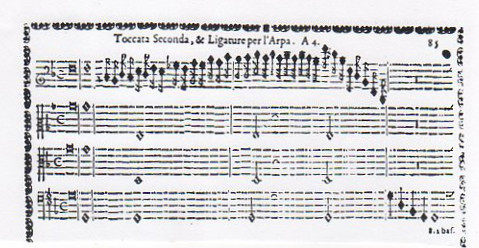

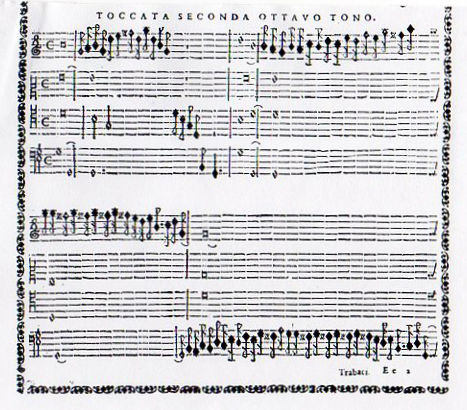
19.24 Toccata VII of the nine unpublished toccatas attributed to Frescobaldi in the Turin tablatures opens with a d minor chord arpeggiated downward over three and a half octaves.
19.25 “In going on,” Frescobaldi goes on,
be careful to distinguish the sections, taking them more and less strictly in accordance with the difference of their effetti, which appear by playing (1615). In these compositions titled Capricci, I have not maintained as easy a style as in my Ricercari. But one must not however judge their difficulty before putting them well into practice on the instrument where with study one will know the affect that it must have (1624).
19.26 For subsequent contrasting passi Scipione Giovanni advised:
When you find passages of Songlike affetti, you must take a broad tempo with the fermatas appropriate and Suitable to the affetto. [17]
19.27 Structural cadences, no matter what note-values are employed to notate them, are to be held, and the tempo is gradually slowed in approaching the end of passaggi or cadences: “Let cadences be drawn out very much” (1615); “Although the cadences may be written fast it is proper to sustain them very much; and in approaching the concluding of the passages or cadences one will go on drawing out the tempo more slowly” (1616); “… the Cadences [must be] sustained greatly before beginning the next section” (1624). This was presumably general practice, since Trabaci also recommended broadening the tempo at specified cadences.
Performance of passaggi
trill plus passaggio: When you find a trill of the right or left hand, and at the same time the other hand has a passaggio one must not divide note for note, but only seek that the trill be fast, and the passaggio be taken less rapidly and expressively: otherwise it would cause confusion (1616).
1. In the Toccatas [of the Fiori] when you will find some trills, or affettuoso passages play them slowly and in the eighths follow in the parts together to make them somewhat allegro and in the trills let them be taken more adagio slowing the beat although the toccatas must be played at the pleasure of the player according to his taste (1635). [18]
eighths and sixteenths: When one finds some passage of eighths and sixteenth together in both hands, it must not be taken too rapidly: and that hand that will play the sixteenths must play them somewhat dotted, that is not the first, but the second should have the dot, and so all the first no, and the second yes (1616) [see below].
In his direction to “swing” the eighth notes Frescobaldi is following a performance tradition:
Bovicelli 1594, 14: “… dotting every other eighth note” (“…facendo i ponti ad una croma si, e l’altra nò….”)
19.28 Severi 1615: eighth-note passages with the first eighth dotted “are sung in a lively way, but not too quickly, and the dots are not stressed.” Passages with the second eighth dotted “are sung with liveliness but not very quickly, and the dots are not emphasized / … when the second eighth is dotted they are not sung very quickly …. it will be necessary to pass quickly over the first Eighth, and stop on the second …. Let the sixteenths be sung in a lively manner and as fast as possible provided that they are [sung] detached from the chest, and not from the throat…”[19]
19.29 Puliaschi 1618: “…. performing the passaggi now with their flowing movement, & with the trills, so that they stand out in a lively manner; and now dotting the first note, now the second as the passage requires…”[20]
Fasolo 1645 [3]: … the beginning [eleuatione] of the versets, cantus fermi as well as fughe, must be played allegro, and where there are eighths, or sixteenths, they are played as if they were half dotted so that the melody comes out more spirited.[21]
passi doppi: In double passages similarly go slowly, so that they may stand out better, and in descending by a leap let the last note before the leap be always resolute, and swift (1615). Before playing the double passages with both hands in sixteenths one must pause at the preceding note, even if it be black: then play the passage resolutely, in order to show so much more the agility of the hand (1616).
19.30 Note that Frescobaldi repeatedly cautions against rushing passages whose notation might suggest to the modern performer a virtuoso display: a passaggio against a trill is to be taken “less rapidly and expressively”; in “trills, or affettuoso passages play them slowly”; passages of combined eighths and sixteenths “must not be taken too rapidly”; in double passages “similarly go slowly.”
“Not leaving the Instrument empty”
19.31 The phenomenon of decay is particularly characteristic of Italian harpsichords and both demands and facilitates a wide vocabulary of arpeggiations. In the arpeggiated openings of Frescobaldi’s toccatas the varied speed and patterns of the arpeggios can reveal the relations of harmonic intensity between the chords or botte ferme, as in Louis Couperin’s unmeasured prelude related to the first toccata of Froberger, with its rich arpeggiations, interpolated passing-tones, and ornaments:
Ex. 19.2 a. J. J. Froberger, Toccata I, mm. 1-3 b. Louis Couperin, Prélude à l’imitation de Mr. de Froberger
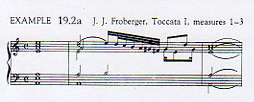
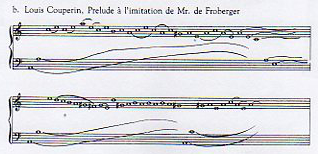
19.32 Alessandro Piccinini, Frescobaldi’s former colleague in the service of Enzo Bentivoglio, described the treatment of suspensions and other dissonances by Neapolitan lutenists (1623):[22]
… where the music is full of dissonances, for the sake of variety it succeeds very well sometimes to play as they do in Naples, where they restrike the same dissonance several times, now soft, & now loud, and the more dissonant it is, the more they restrike it, but in truth this [manner of] playing succeeds better in practice than in words, and particularly for those who relish affettuoso playing.
19.33 Frescobaldi transferred this practice to the keyboard: “… in the ties [suspensions], or dissonances, as also in the middle of the work they will be struck together, in order not to leave the Instrument empty: which striking will be repeated at the pleasure of the player” (1616). A Turin manuscript of a toccata attributed to Frescobaldi notates this effect of restriking:
Ex. 19.3 a. Turin I, Toccata 7, ff. 44-46, mm. 13-15 (Tagliavini 1983, 300)

b. Toccate II/1: mm. 36-39

19.34 “In certain dissonances it is appropriate to stop there and to arpeggiate them so that the following passage comes out more spirited” (1624). (This does not mandate the incessant breaking of every vertical sonority that some harpsichordists currently affect.) The injunction “not to leave the Instrument empty,” which was repeated by Frescobaldi’s successors,[23] has wider applications than the mere arpeggiation or repetition of chords. Otherwise well-intentioned performances of Girolamo’s works are marred by miscalculations of timing and ugly breaks in the line, the result of insensitivity to the decay of harpsichord sound. The harpsichord, in general, has a curious power of projection, of shouting on the housetops what is whispered in the ear. Unfortunately, what it projects most clearly is the performer’s failure to conceive and prepare a passage adequately. One way around the emptiness of cadences on an Italian harpsichord is the shaping of what precedes the cadence so that, even if it is a full chord after an open texture, its arrival is perceived as a point of repose.
Mensurations
19.35 Duple meter: The symbol C is Frescobaldi’s usual indication of duple meter. (Like his contemporaries, he also employed C to indicate the absence of perfection in the ternary groupings of the Romanesca.) The sign ¢, tempus imperfectum diminutum, which he employs only once, could denote a) its original proportional meaning of twice the speed of the preceding C b) an undefined acceleration c) or no change in tempo at all. For Frescobaldi ¢ probably signified the first or second alternatives, cut time or “somewhat lively in beat” (1616): in both versions of the Romanesca for a section without passaggi he replaced the prevailing C indication with ¢ (1615, parte 7; 1616, parte 8). For Trabaci ¢ had an additional meaning (1615, 41): “… for all those versets which have a cut Circle, they will be played in strict Time [Battuta stretta]…”[24]
19.36 Etienne Darbellay has posited two kinds of duple meter in Frescobaldi. Sections barred in breves and notated in long notes (such as the fantasie and the opening portions of the capricci) indicate a rather fast semibreve tactus but a relatively slow tempo; sections barred in breves or semibreves and featuring eighth- and sixteenth note-values denote a slow minim tactus but a fast tempo (see Chapter 14).[25] This seems to obtain in Trabaci 1615, 77ff.: versets in C comprise two half notes per measure and are notated in smaller note values; versets in ¢ consist of two whole notes to the measure, they are notated in halves and quarters and are marked “In Battuta stretta.”
19.37 Triple meter: Frescobaldi’s one statement on mensurations is contained in the preface “A gli studiosi dell’opera” of the 1624 Capricci:
…and in the triplas, or sesquialteras, if they are major [e.g.,
3/2  ], that they be taken adagio, if minor [
], that they be taken adagio, if minor [ ] somewhat more allegro, if of three quarters more allegro[3
] somewhat more allegro, if of three quarters more allegro[3 ;] if they are six for four let their tempo be given making the beat move rapidly (1624). [26]
;] if they are six for four let their tempo be given making the beat move rapidly (1624). [26]
19.38 In sesquialtera maggiore a measure of one or two whole-notes in C = a measure of three whole notes. In sesquialtera minore one whole note in C = three half notes. For a measure “of three semiminims,” a half note in C = three quarters.[27]
19.39 For convenience we repeat here a synopsis of Stembridge’s lists of triple mensurations in Frescobaldi’s Toccate I, II, and Capricci (Stembridge 2009, 2013, and 2015):
Table 19.1. Keyboard triple mensurations
| three whole notes: sesquialtera maggiore | |
| O3/1 | three wholes notes: sesquialtera maggiore |
| O | three whole notes |
| O3 | three whole notes |
| O3 | three half notes |
| O 3/2 | three wholes notes: sesquialtera maggiore |
| |
two dotted whole notes |
| two dotted whole notes | |
| three half notes: sesquialtera minore | |
| three halves: sesquialtera minore | |
| two dotted halves: sesquialtera minore | |
| three quarter notes[28] more allegro | |
| 3 | three halves: sesquialtera minore |
| three quarters: more allegro | |
| ¢3, ¢3/2 | three black whole notes: sesquialtera maggior |
| three quarters: more allegro | |
| 3 | two dotted halves: rapid beat |
| 3 | dotted half = half of previous C: rapid beat |
| 3 | three or six black quarters: rapid beat |
| 6/4 | six quarter notes |
| C 6/4 | six quarter notes |
| 6/4 | two whole notes = four dotted halves |
| 12/8 | twelve eighth notes |
19.40 Girolamo’s employment of unequivocal proportions is sparing. The notational evidence of his music leaves no doubt that 6/4 (cancelled by 4/6) and 12/8 (cancelled by 8/12) are proportional equivalents to a preceding or simultaneous C, and in some instances 3/2 also seems to be proportional, as in Fantasia II, Toccate II/9, and the capriccio “Fra Jacopino.” Yet he himself says only “… if they are six for four let their tempo be given making the beat move rapidly” (1624) and does not mention the other proportions.
19.41 In its untidy adoption of certain proportional devices and its general loosening of proportional tempo relationships, Frescobaldi’s practice reflects the contemporary erosion of Renaissance notational principles. In notating triple meters, Frescobaldi occasionally retained the archaic convention of perfection (a two-beat note before another of the same value is perfected to three beats), as in the opening of Iste Confessor; otherwise he added dots. He applied coloration (black notes) not only to sesquialtera but also to major and minor hemiola: ![]() and
and ![]() . Reverse hemiola (white notation) also occurs, as in Canzona II of Toccate II.[29] The simplification of his ternary values in secondary sources of his music indicates that his contemporaries did not always understand such subtleties.[30]
. Reverse hemiola (white notation) also occurs, as in Canzona II of Toccate II.[29] The simplification of his ternary values in secondary sources of his music indicates that his contemporaries did not always understand such subtleties.[30]
19.42 The features of older notation that he did retain, however, Frescobaldi employed to create one of his most dramatic effects, the clash of two against three. It has been asserted that such passages must be “assimilated,” that is, that the duple divisions must be reshaped to conform to the prevailing triple subdivision.[31] But the doctrine of assimilation ignores historical, notational, and musical evidence. Renaissance notation abounded in devices for producing simultaneous congruent duple and triple subdivisions, and a glance at the enchained mensurations of Toccate II/9 will show that Frescobaldi was fully aware of such possibilities. The doctine of assimilation is somewhat strained by mm. 11-13 of that work, where the same dotted figure would have to be assimilated both to a single sixteenth sextuplet and to a triplet eighth. The doctrine fails completely in Toccate II/11, where the dotted figure is counted out over eight bars as a measured sixteenth, but two bars later it must suddenly assimilate itself as an eighth-note triplet.
Ex. 19.4 Toccate ll/11, mm. 55-64

19.43 The fact is that Frescobaldi possessed the resources to notate assimilation, and when he wanted it, he did so:
Ex. 19.5 Toccate II/11, mm. 21-29

19.44 This is confirmed by Grassi’s notes to the Canzoni:
If they [the readers] find some unaccustomed tempo, that is, with one part signed with a proportional signature, & the other following the ordinary tempo, let them not therefore believe that it is by error, but let them consider well the score (1628).
19.45 Where Frescobaldi wanted rhythmic alteration of his printed text, he specified it in his prefatory material (see also the following discussion of fingering). Two effetti are described as demanding such alteration:
Ex. 19.6 Toccate I/3, mm. 22-25

When you find a trill of the right or left hand, and at the same time the other hand has a passaggio one must not divide note for note, but only seek that the trill be fast, and the passaggio be taken less rapidly and expressively (1616)
When one finds some passage of eighths and sixteenth together in both hands, it must not be taken too rapidly: and that hand that will play the sixteenths must play them somewhat dotted, that is not the first, but the second should have the dot, and so all the first no, and the second yes (1616).
19.46 Thus, a passage notated as in Ex. 19.7a should be executed something like Ex. 19.7b:
Ex. 19.7 a. Toccate I/5, m. 33 as written b. as played

Ex. 19.8 Toccata I/2, mm. 24-25: written Lombard (see also Ex. 19.49)

19.47 A few rhythmic alterations depended on convention. A dotted pattern beginning with a rest and a note of equal value was executed in conformity with the pattern, as a dotted rest and short note:[32]
Ex. 19.9 La Monica, parte 11, mm. 4-6

19.48 Dotted figures were also continued in contexts where the unavailability of double dots made their precise notation impossible. Frescobaldi and his contemporaries did not always notate dotted rhythms consistently after their first appearance, and there are places in his music where logic suggests the continuation of a dotted figure. The same is true of the addition of ties. (In the 1645 Canzoni, for example, many of these were missing in the print and were added by hand.) Tagliavini 2010, xviii-xix, suggests that a dot after a note may be intended to indicate a hold:
Ex. 19.10 a. Fiori musicali, Messa delli Apostoli, Canzon quarta, m. 53-57

b. Messa della Madonna, Girolmetta, m. 47-51

19.49 Frescobaldi’s pupil Froberger dots the first note of a passaggio in sixteenths and makes the second note a thirty-second, which suggests that the initial dot is really a corona, after which the passage continues in even sixteenths.
19.50 Frescobaldi’s most idiomatic keyboard writing is animated by a seemingly endless variety of rhythmic invention. The two-against-three patterns of Toccate II/9, for example, occur in a dazzling succession of permutations (cf. mm. 29, 32, 50, 65) whose changing or recurrent densities of texture both vary and unite the work. Another of Girolamo’s effects is the placement of rhythmic phrases so that they overlap changes of hand position or other types of physical articulation, and the challenge to the performer is to prepare the phrase so that it moves over, and not between, the physical obstacles. Excitement may also be generated by the combination of a number of rhythmic units having non-simultaneous downbeats, ranging from meteor-showers of tiny imitations to the convoluted cross-accents of passi doppi:
Ex. 19.11 Toccate II/7, mm. 30-48
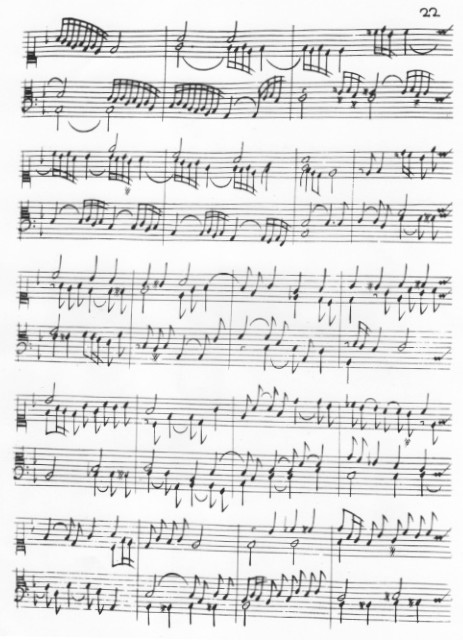
19.51 In treating Frescobaldi’s rhythms performers cannot be content with reproducing their notational outline; they must first understand the sources and direction of their rhythmic energy. Unfortunately, the whole concept of a rhythmic phrase, a unit accumulating intensity toward a functional downbeat or dissipating energy from it, is too often replaced by regular stressed downbeats as indicated by barlines. (It goes without saying that downbeats are as perceptible on “non-accentual” instruments such as the harpsichord and organ as they are on ones capable of dynamic contrast.) What appear at first to be technical problems in Frescobaldi (and elsewhere) are often musical ones, and they frequently spring from faulty perception of the functional downbeat of a phrase in terms of what prepares and follows it, or from the attempt to jam more than one downbeat into a single phrase. How many performances of galliards are hamstrung by the player’s inability to perceive that the first measure is an upbeat, and that no downbeat occurs until the second bar of the phrase (an observation confirmed by seventeenth-century choreography).
19.52 Frescobaldi gave to the formulas of his predecessors a new rhetorical, expressive content, to which an understanding of rhythmic direction is essential. The combined trill and turn (groppo: see below) which is the most frequent cliché of Andrea Gabrieli and Merulo achieves an expressive urgency when conceived as the gradual accumulation of energy to explode in a downbeat and performed as an acceleration with additional beats. Unfortunately, this intensity is often vitiated by the performer’s insensitivity to the declamatory possibilities of the figure:
Ex. 19.12 a. Trill/turn, gradual acceleration 2b. conventional execution


19.53 These may seem small and relatively trivial details, but it is the essence of a rhetorical style in any of the arts that no gesture be unimportant, haphazard, or meaningless.
Fingering and articulation
19.54 Antonio Libanori claimed that “[Frescobaldi] even played those very difficult Sinfonie, & most ingenious toccatas, at sight with his hands reversed, that is with the palms turned up, he had hands so agile, ready, and swift.”[33] Nonetheless, we may assume that Girolamo usually followed more conventional habits of keyboard playing as transmitted by Diruta and Banchieri.
19.55 Diruta summarised his advice on keyboard playing in introducing ornamented playing (f. 8):
Now we come to diminutions, & above all you must remember in what manner one must keep the hand straight with the arm & as if somewhat cupped, and the fingers curved, and equal, so that one [finger] is not higher than the other, & that they do not harden, nor get on each other, nor draw back, and that they do not beat the Keys, and that the arm guides the hand, & that the hand, & the arm be always above the Key that is played, and that the fingers detach well the Keys, that is, that one Key is not struck until the finger is lifted from the other, & that they be raised, and lowered at the same time. Advising you not to raise the fingers too much above the Keys, & and above all to keep the hand lively, & light.[34]
19.56 (Contemporary Italian portraits confirm that the placement of the thumb and fifth finger determined the position of the hand, with the longer fingers curved to accommodate them.)
19.57 Diruta contrasts these prescriptions with the defects of earlier keyboard technique:
… a difficulty, about carrying the fingers of the right hand, that when they play ascending, they hold the second finger stretched out and strained, & even the large [middle] finger strained under the hand, & the fifth finger drawn back too far, which [fingers] are in such a position, in both hands, they they become hardened, and strike the black keys in such a way that the other fingers cannot move with agility.[35]
19.58 Diruta noted that some organists
…strike the keys and [then] raise their hands from the keyboard so that they make the Organ remain without sound for the space of half a beat, and quite often a whole one, so that it seems, that they are playing quilled instruments, and that they are about to begin some Saltarello.[36]
Frescobaldi’s one reference to fingering, in the context of organ music, suggests that he shared something of Diruta’s norm of sustained organ sound: “In the Canti fermi [of the Fiori musicali] although they are tied[,] in order not to impede the hands they can be untied for greater ease when one has used all the facility one knows” (1635). In fact, the only long ties in the Kyries are not in the chants themselves but in pedal-points, which therefore would sometimes necessitate finger substitutions in order to be performed legato as written.
19.59 Despite Frescobaldi’s documented mastery of both organ and harpsichord, Diruta claimed that harpsichordists will “never, or rarely” play real music (“cose Musicale [!]”), while organists will “never play dances on quilled instruments well” [I, f. 5v]. For the harpsichordist
[f. 6]: The instrument must be evenly quilled so that it plucks easily, and must be played in a lively manner so the harmony is not lost; and it must be ornamented with tremolos, and graceful accenti: & that same effect made by the wind of the Organ in sustaining the harmony, you must make on the quilled instrument; For example, when you play on the Organ a Breve or Semibreve you hear the complete harmony without re-striking the Key: but when you play the same notes on a quilled instrument you will lack more than half the harmony: therefore you must make good such a lack with the liveliness, & dexterity of the hand by striking the Key lightly several times.[37]
19.60 The organist wishing to play dances on quilled instruments must make two exceptions to the legato ideal: hand-leaps and striking the keys with the fingers: “quilled instruments should be struck [lit. beaten] because of the Jacks, and the plectra, so that they play better.” In dance music Diruta allows the players “to leap with the hand to give grace, & air to their dances.”[38]
19.61 A certain amount of common sense is required in the interpretation of this passage. The resistance of harpsichord action, unlike that of the piano or clavichord is greatest in the middle of the stroke, at the point where the plectrum passes the string; beyond that, no more weight is required than what is necessary to hold the key down. Diruta presupposes a well-quilled instrument playing dance music, in which the maintenance of rhythmic vitality is the primary consideration (indeed, an occasional thump or two is sometimes an aid to dancers).
19.62 Diruta proceeds to explain the fundamental concept of “good notes” (note buone) and “bad notes” (note cattive)—notes falling on strong or weak beats or subdivisions, a distinction paralleled by the placement of up- and down-bows in seventeenth-century string playing. Diruta’s detailed examples show that in passages of notes in equal value the notes begin with a good one and alternate regularly with bad ones; an initial rest (of the same value as the notes) or a dot on the first note does not affect the succession. Where the initial rest or note is twice the value of the notes in the remainder of the passage it counts as both a good and a bad note, and the succession continues with a good one. In general (see the section on ornamentation for exceptional fingerings), the good and bad notes are assigned to good and bad fingers. In both hands the bad fingers are 1, 3, and 5, the good ones 2 and 4. A good finger may be repeated on two successive good notes.
19.63 Diruta’s scale-fingerings bear out his observations that in fast passaggi (note negre, “black notes,” not to be confused with tasti negri or black keys ) fingers 2, 3, and 4 “do all the work” (“fanno tutta la fatica”): 3 is pivotal and 4 weak.[39] He admits that “many capable men” (“molti valent’uomini”) employ another fingering for scales in the left hand: [3], 2, 1 ascending, 3, 4 descending, but he contends that this has the disadvantages of landing the thumb on a black key when the signature has a B-flat and of placing undue stress on the weak fourth finger of the left hand.[40] Banchieri contents himself with fingerings for right- and left-hand scales that seem to follow more general practice (confirmed in BisMantova 1677 and Penna 1684) in treating 3 as a principal good finger in both hands. A salto cattivo is a leap after a good note, a salto buono a leap after a bad one. The fingerings given by Banchieri and Diruta for intervals show that 1 and 5 were employed where appropriate (Ex. 19.00).[41]
Table 19.2: Seventeenth-century Italian scale fingerings:

(for more complete examples see Stembridge 2010, xxxix)
19.64 Fingers were usually changed for repeated notes, since taking them with the same finger elicited special comment: the manuscript BAV, Vat. mus. 569, from the Frescobaldi circle specifies “tasto solo” for repeated notes in a Trombetta and Battaglia, presumably for a bellicose rattle. The Vatican manuscript Chigi Q. IV. 28 indicates “With a single key” (“Con un tasto solo”) for repeated notes and a repeated-note “trill [to be played] with one key” (“il trillo con un tasto”), like a vocal trillo—a caution against always interpreting “trillo” as an alternating-note trill.[42] For unisons in counterpoint Diruta advises:
When you find one part that enters at Unison with the other, and both present some subject or answer, you must strike the Unison with both hands, & after striking the Unison let one of the parts stay still & the other go on its way.[43]
19.65 The principal difference between these systems and modern fingering is of course the practice of passing a long finger over a short one (or even the reverse, as in Diruta’s left-hand scale), as opposed to the modern system of passing the thumb under. After the publication in 1915 of Arnold Dolmetsch’s The Interpretation of the Music of the XVIIth and XVIIIth Centuries, the study of early fingerings tended to emphasize the long-over-short pattern and to draw from it a doctrine of pervasive long-short, two-note slurs. This overlooks the distinction between abstract and expressive fingerings (the treatises provide only the former) and is contradicted by the very sources of these fingerings. As early as 1565 Tomás de Sancta Maria provided a variety of highly sophisticated fingerings and possible unequal realizations of notationally equal notes: not only long-short, but short-long, and short-short-short-long. In pressing the keys of the clavichord, he advised, “the finger which touches the first is always lifted before the one that immediately follows it is touched.”[44] Diruta noted that in playing diminutions “the next key is not struck until the finger is removed from the first.”[45]
19.66 A Milanese manuscript “Metodo per il clavicordo” (“Method for the harpsichord”) dated in the first half of the seventeenth century suggests that surviving descriptions of early fingering such as those of Diruta and Banchieri were not the only possibilities, and that practice was in flux:
For employing the hand there are many rules because one person uses the hand in one way and another [person uses it] in another. For this reason one must not write rules of any sort and it is just necessary to leave the convenience to the habit of the student but not in the old custom, as not with the two fingers up and down, but with the right hand, stepwise going up, and all the virtuosi use the second and third [finger] in this left hand.[46]
19.67 Early fingerings do not demand slurs corresponding to successive pairs of fingers: in his Flores de musica of 1620 Manuel Rodrigues Coelho stipulated that “… diminutions in the left and right hands must be equal so that one key does not sound more than another and [must] give equality to the halves, eighths, and sixteenths.”[47] In the last few decades appropriate historical keyboard fingerings have become an integral element of performance practice, and a skilled player can learn to play as rapidly, as brilliantly, and as evenly with them as with present-day fingerings. Perhaps the last word should be left to Frescobaldi’s contemporary Michael Praetorius:
Some persons get special notions about such things, and wish to despise Organists who are not accustomed to this or that fingering.[48] But this, it seems to me, is not worth discussing. Let one run up or down [the keyboard] with the first, middle, or last finger, and even with his nose if it helps, for as long as what he plays sounds fine and pure, and is correct and pleasant to the ear, it is not very important how one accomplishes it.[49]
19.68 Since early fingerings are less capable of unlimited extension, or at least less concerned with it, they force the performer to consider smaller units of meaning and their relation one to another.[50] The study of seventeenth-century fingerings is thus perhaps the simplest (but by no means the only) way to bring keyboard players up against the question of articulation, which their instrument poses only indirectly. The instrumental and vocal tutors of the sixteenth and seventeenth centuries demonstrate the central importance of articulation by their extended considerations of breathing, tonguing, fingering, and bowing. Not only are the spaces between the notes in a sense as important as the notes themselves, but the variety and richness in the articulation of those spaces possible on historical instruments and the best modern reproductions are increasingly explored.
19.69 One external key to the articulation of Frescobaldi’s two books of toccatas has been proposed, the notation of the original engraved editions.[51] The beaming of notes in the original would indicate groupings conceived and to be executed as a unit, and the division of notes that might otherwise be beamed would show that they are to be separated. The engraving of the two books is certainly of a precision capable of such distinctions, extending even to careful alignment in the two-against-three passages of Toccate II/9. But the proposal raises a number of questions. First, if beaming was intended as a guide to articulation, why does Frescobaldi not point this out, as Grassi called attention to the care he had taken in aligning the parts in the Canzoni score? Second, the idea was suggested to Darbellay by a similar practice in late eighteenth- and nineteenth-century German music printing, but St. Lambert (1702), a source nearer Frescobaldi in time if not in place, specifically contradicted such an interpretation of printed texts.[52] Finally, there are passages in which such a reading seems contrary to musical logic. In any case, this notational convention, if it indeed existed, is valid as an indication of articulation only at the primary level of groupings; it cannot indicate relations within a unit or between large units, for which it is necessary to consider the nature of articulation.
19.70 Any musical composition is a constantly shifting web of relationships—formal, tonal, melodic, harmonic, motivic. Articulation, the movement from one note to the next in a specific context, is a response to all of these factors. Keyed instruments, especially the harpsichord, have always evoked experiences whose physical reality is beyond the capacities of performer and instrument: the human voice, other instruments, the dance. Keyboard articulation has as its source vocal inflection both in its delineation of melody and in the wide spectrum of vowel and consonant color and definition, enriched by the analogues of breathing and bowing in instrumental music. Beyond this, the player must also bring to bear, in dealing with Frescobaldi, an awareness of the elements that formed his keyboard style: the contrapuntal tradition of the late Renaissance, the resources of affective declamation, and the continuo player’s sense of underlying harmonic structure and inflection.
19.71 In some cases, as in Frescobaldi’s variation-sets, a clear and repeated harmonic structure is the given of the work, which becomes an interplay between a constantly varied figural surface and a clearly articulated harmonic armature. In other instances a work may seem to evolve so organically that its structural coherence is apparent only in retrospect. Yet beneath the surface of even the most arbitrary succession of musical events in Frescobaldi there is a logic that serves to guide the articulation of notes within the musical structure. Especially in the preceding analysis of the toccatas we have seen the role played by significant detail, the raw material of articulation, in such evolutions, where a pebble dislodged at the beginning of a work precipitates an avalanche further on. A case in point is the opening of the ubiquitous ninth toccata from Book II:
Ex. 19.13 Toccata II/9, mm. 1-16
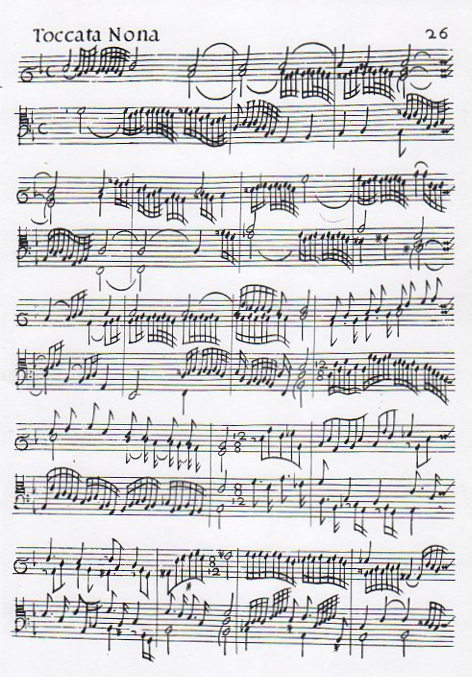
19.72 Although virtually every rhythmic and harmonic destination in the excerpt is reached by the same cadential figure, in each context it acquires a different meaning. The soprano D in m. 1 is the first departure from the F triad; the alto A in the same measure is an indecisive confirmation of the triad; and the jagged descending bass entrance in mm. 1-2 sets the whole harmonic fabric in motion. The high F at the end of m. 3 juxtaposed with the the low F in the bass, approached by E, outlines the range that dominates the remainder of the toccata.
19.73 The communication of these musical facts in performance is dependent on the articulation of the notes: their preparation and spacing, guided by vocal and harmonic feeling in terms of their contexts. Clearly the E-flat in m. 6, the pivot away from F major, demands a preparation different from the assertive F-major triad that precedes it, just as the comparative rhythmic regularity of m. 8 and its upbeat requires an articulation that outlines the basic interval of each figure. Measures 22-25 make these points even more clearly: mm. 22-23 and mm. 24-25 are related in their presentation of rising figures against a pedal-point and in their rhythmic sequences, but every unit of each passage and both as a whole are differentiated by varying degrees of melodic and harmonic stability. No musical repetition can ever be exact; even if the context remains unchanged, every repeat is either an intensification or a relaxation of the original. Thus the appoggiatura ostinato in m. 22 must be articulated differently in each new harmonic context.
19.74 Measures 24-25 epitomize one of the most difficult tasks in performing these works: the perception and communication of simultaneous rhythmic motion on levels ranging from that of the fundamental harmonic movement to that of the most intimate details of its superficial ornamentation. Functionally, the measure is merely a prolongation of the dominant pedal at the end of m. 23, but it moves harmonically at the levels of the whole note, quarter, and eighth, melodically at the level of the sixteenth notes, and rhythmically at all of these in addition to the unmeasured pedal-point trill. Further, such passages must be played in relation to notes that are decaying, that have ceased to sound, or that may not have been stated explicitly at all.
Ex. 19. 14 Toccata II/9, mm. 17-30

Musica ficta
19.75 Musica ficta denotes the convention of altering a written pitch in certain circumstances. In seventeenth-century notation an accidental sign (flat, sharp, or natural) was placed either preceding or below (in that case not to be confused with a continuo-figure) the note to which it pertained. The sign was valid only for that note unless the note was repeated immediately (often not after even one intervening note) or formed part of a written-out trill. On the other hand, if the note were repeated across the bar the accidental remained valid. An accidental could also be employed like a natural sign (e.g., a sharp to cancel a preceding flat).[53] In certain circumstances, such as cadential ornaments, a written accidental could be projected back to the beginning of the figure, as Vincenzo Galileo noted in his Fronimo (1584):
Although the composer did not sign the first semiminim of each bar & the other accidental figures with B-flat: this does not mean that they [the B-flats] are not understood, & the same must often be understood on the first minim of each example similar to one of these. [54]
19.76 Ficta was also employed to raise the seventh degree (“leading tone,” sensibile in Italian) before a cadence created by two voices moving to a unison or octave:
Ex. 19. 15 C [#] D C# D against E-D or C D C D against E [b] D)

19.77 A minor chord at the end of a section might be raised by a Picardy third.
19.78 Seventeenth-century musical theory was still based on the hexachord, a module of six ascending pitches, ut re mi fa sol la, whole-tones with a half-tone between the third and fourth degrees, mi and fa, and beginning on one of three pitches: C (naturale), G (hard, durum), and F (soft, mollis, with B-flat).[55] Ficta was applied to correct the melodic or harmonic interval of a tritone by hexachord substitution, either by lowering the upper voice by a half-tone or by raising the lower voice by the same interval (e.g. F/B-natural, corrected either by reading the B as fa in the soft hexachord instead of mi in the hard hexachord or by raising the F). Diatonic scales might also suggest different chromatic inflections according to whether they descended or ascended. Problems of ficta are especially apparent in cadences. Tagliavini 2010 (xviii-xviv) individuated several possible ficta solutions for common cadential formulas in the Fiori musicali:
Ex. 19.16 Tagliavini 2010, xviii-xviv


19.79 A simpler case of the alteration of a printed text is represented by correction of misprints.[56] In addition to internal evidence, these may be revealed by comparison of various states or editions of a volume or by collation with other printed or manuscript sources, such as the Turin codices. (For the process of correcting printed volumes see Chapter 4; for corrected and uncorrected errors see the notes to the volumes of the Stembridge edition.) Frescobaldi is known to have corrected mistakes in his prints by hand before surrendering them to prospective buyers, but surviving copies do not seem to have been examined with this in mind.
Ornaments and ornamentation
19.80 Controversies about the minutiae of ornamentation have tended to obscure its essential character in the sixteenth and seventeenth centuries. It was not a cerebral attempt to realize an historical imperative but a natural expression of technical skill and musical imagination grounded in the conviction that any precious object, whether a piece of music, an ostrich egg, or an ancient building, could be rendered more beautiful by embellishment, and that unadorned repetition represented a lack of musical imagination. In practice, ornamentation was neither a totally free improvisation nor the laborious recombination of textbook formulas but rather an individual response, conditioned by training and experience, to certain conventional stimuli. (A growing familiarity with earlier music is providing something of this context for the best performers.)
19.81 The literature on the practice of ornamentation relevant to Frescobaldi’s keyboard music covers over a century, from Tomás de Sancta Maria’s Arte de tañer fantasia of 1565 to Lorenzo Penna’s Primi albori musicali of 1684. It embraces encyclopedic works, diminution treatises, instrumental tutors, and collections of music. The performing media encompass voice, keyboard, and string and wind instruments.[57] The size of this body of information should not blind us to the fact that, in the last analysis, it is all a commentary on an existing, audible musical practice which is now lost to us. If one imagines trying to reconstruct the style of the great jazz pianist Art Tatum from published reviews, a jazz textbook, a collection of finger exercises, and the sheet music for “Honeysuckle Rose,” that will provide a fair idea of the difficulties involved in recreating an Arcadelt madrigal as embellished by a virtuoso performer around 1600.
19.82 Late Renaissance embellishment ranged from simple conventionalized ornaments or graces (effetti) to elaborate and extended passaggi decorating a preexisting model, like the madrigal intabulations for keyboard and harp of Trabaci and Mayone. The quinta voz settings of Diego Ortiz, where a new descant was added to the original four-part chanson or madrigal, in effect created new works (cf. Frescobaldi’s two compositions with an “Obligo di cantar la Quinta parte”). Such embellishments were to be added in performance, either worked out beforehand (especially in ensemble music) or improvised. Improvisations were not completely free, however, since the literature provided the performer with literally hundreds of formulas for each musical situation: to the printed text of his treatise on recorder playing, Opera intitulata Fontegara (Venice, 1535), Sylvestro Ganassi added 175 additional handwritten variants of one cadential formula. Such formulas were employed as modules, with examples provided for their combination in more extended diminution. The prevalence of intabulations, performed more or less at the tempo of their undecorated originals, suggests that late Renaissance embellishment was above all light, brilliant, and decorative in intention, as Diruta described it.[58]
19.83 The innovators of the early seventeenth century, notably the musicians conventionally lumped together as the Florentine Camerata, did not so much invent new forms of embellishment as change the spirit in which it was employed. Many of their ornaments were in fact taken over from Renaissance practice, but they were now intended for expression as well as for decoration, to enhance the affective rhetorical style of Florentine monody. Their employment at the pleasure of the performer was also considerably curtailed.
19.84 The influence of Florentine expressivity can be traced in such works as the second part of Il Transilvano and in Frescobaldi’s reference to “Madrigali moderni” (which presumably included the solo settings that Caccini published under that designation) as models for the performance of his toccatas: “taking [the beat] now slowly, now rapidly, and even suspending it in the air.”
19.85 The sources of sixteenth- and seventeenth-century keyboard music, still emerging, make it increasingly clear that a single text, even when emanating directly from the composer, is not a blueprint for a performance. The ricercari of Claudio Merulo demonstrate the fluidity of written texts. The printed edition of 1567, issued during Merulo’s lifetime, contains the most elaborate ornamental realizations. The posthumous edition of 1605 (Venice, Gardano) simplifies the ornamentation, but the source of this version (possibly an earlier manuscript version by Merulo himself) is unclear: perhaps the 1567 print represents the kind of ornamentation that would have been added in performance to the more skeletal version of 1605. The manuscript versions in the Turin tablatures (1637), while agreeing mainly with 1605, also present variants concordant with neither print. (The ricercari, originally in published in chiavette or high clefs, were transposed down a fourth in Turin).
19.86 Indeed, there are circumstances where the written text seems not the precondition for a performance but rather the formalized end result: “… if a beginner, who plays things that he has studied, & learned disgracefully incorrectly, wishes to play according to the rules it will be necessary for him to abandon all that he has learned …”[59]
The repertory of ornaments
19.87 Italian practice distinguished two types of ornament, the smaller localized decoration (effetto, accento) and the extended virtuoso passaggio or gorgia, applied in varying degrees to both vocal and instrumental music. Smaller ornaments were essentially decorations of simple melodic progressions, usually conjunct ones; they normally occupied half the value of the note to which they were applied.[60] Ornaments could be written out in full; they could be indicated by a conventional sign either alone or combined with a contextual shorthand; or they could be added freely by the performer in customary places (e.g. cadences).
19.88 In Syntagma III Praetorius provides a basic grammar of ornaments: “Diminution is when a larger note is resolved and broken into many smaller and faster notes … following in ascending order, [diminution] consists of Accentus, Tremulo, Gruppi and Tirata.”[61] Praetorius’ categories can be summarized as melodic, repercussive, and compound ornaments. (NB: ornaments are like Mediterranean fish: sometimes different names are applied to the same thing, sometimes different things have the same name.)
Melodic ornaments
19.89 The simplest ornaments, Praetorius’ accentus, decorate unisons and single intervals, both ascending and descending, in a wide variety of rhythmic patterns that include both on-beat and pre-beat forms:
Ex. 19. 17
a. Cavalieri (1600), monachina
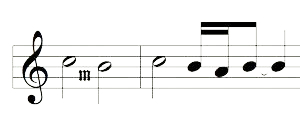
b. Zacconi (1592), fol. 56: ornament and pre-beat interpretation

c. Bovicelli (1594), pp. 17-19: on-beat and pre-beat ornaments

d. Banchieri, Cartella (1601), p. 50: accenti
![]()
Ex. 19.18
a. Rognoni (1620), fol. 1: “beginning under the note” (cf. Caccini “intonazione”)

b. Rognoni, accenti

c. Rogniono (1592): interval decorations

19.90 Praetorius (III, 233-34) gives accent formulas for unisons and intervals ranging from seconds to fifths, both ascending and descending: “accent is when the notes of the following shape are twisted in half”:[62]
Ex. 19.19 Praetorius, accenti, “First and last notes in unison”:
19.91 Melodic decorations may also be deployed in more complex contexts: 
Ex. 19.20 Bovicelli (1594), p. 13: acccenti sopra le minime ( ˆ = tremolo formato); accenti sopra alle semiminime (ˆ = tremolo non formato)
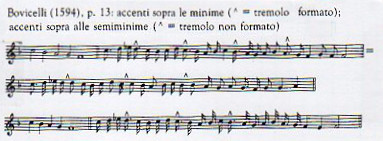
Repercussive ornaments
19.92 Repercussive ornaments—Praetorius’ tremulo (tremolo), trillo—are formed either by repetitions of a single note or by oscillations between the main note and the upper or (more rarely) lower auxiliary. They occur widely in both vocal and instrumental sources, either alone or combined with turns. For Praetorius, “Tremolo or Tremulo is nothing other than the trembling of the voice over a note: Organists call it Mordant or Moderant.”[63] He gives examples with the upper auxiliary and—“not so good”—the lower:
Ex. 19.21 Praetorius, 235: Tremolo
![]()
19.93 Praetorius differentiates two types of trillo, both essentially vocal. The first is a repeated note trill, “on a unison … when one repeats many fast Notes one after another”—the vocal ornament familiar from Monteverdi and Caccini. (For Praetorius’ tremoletti, “more for Organs and quilled instruments than for human voices,” see below, Keyboard ornaments.)
Ex. 19.22
a. Praetorius, trillo
![]()
b. J. H. Kapsberger (1640), trillo with upper, lower auxiliary
![]()
c. Cavalieri (1600): monachina, trillo; zimbelo

d. Caccini (1602): trillo; ribattuta di gola
![]()
e. Rognoni (1620), fol. 1: tremolo in due modi; tremolo alle note di semibreve; trillo sopra la minima; trillo sopra la semibreve primo modo; secondo modo (acceleration)
Compound ornaments
19.94 Compound ornaments such as Praetorius’ Gruppo or Groppi consist of an oscillation between the main note (trillo) and the upper auxiliary, concluding with a turn. Praetorius states that Groppi “are used in Cadences and complete phrases and must be struck more sharply than the Tremolo.”[64]
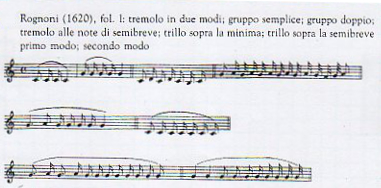
Ex. 19.23
a. Praetorius 236, Gruppo

b. Dalla Casa: groppo battuto de semibreve; groppo battuto de minima

c. Rognoni (1620), fol. 1: gruppo semplice; gruppo doppio

d. Cavalieri, groppolo

e. Caccini: gruppo
![]()
f. Conforti, p. 25: groppo di sopra; mezzo groppo; trillo

g. Conforti, mezzo [trillo]; groppo di sotto; mezzo [groppo di sotto]

h. Conforti, groppo; mezzo [groppo]

i. Conforti, groppo; trillo; mezzo [trillo]

Cadential groppi also appear under other names, such as Dalla Casa’s (1584) tremolo gropppizato de semibreve and tremolo groppizato de minima (cf. Ex.19.23b).
Ex. 19.24
a. Zacconi (1592), fol. 61v: cadenza

b. Bovicelli, p. 12: groppetti
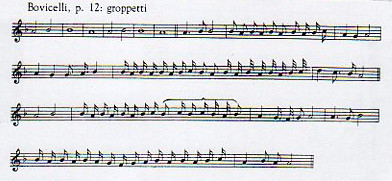
c Virgiliano (ca. 1600), p. [34]: cadences

d. Banchieri (1601): fioretti

19.95 The other kind of trill that Praetorius cites (III, pp. 238-29) is made in a variety of ways and must be learned from a teacher, as birds learn their songs from one another:
Nonetheless I have given here in passing several examples that I considered necessary for the still uninformed ignoramuses, that they might see and know something of what is called a Trillo. [65]
19.96 Praetorius’ Trilli are in fact compound constructions combining accenti, trilli, and gruppi, verging on passaggi in length and complexity:
Ex. 19.25 Praetorius, III, 239:

19.97 The tirata: Praetorius: “Tiratas are long swift little sweeps made stepwise and they run up or down through the keyboard.” They “must be played faster and sharper so that every note is cleanly heard and understood: and the more graceful the better.”[66] Bovicelli 14: In thirty-seconds: “…in a tirata of many stepwise notes [it will make a good effect] if you hold the first longer than the following” (“…in una tirata di molte note per grado si tiene la prima più delle seguenti…”).
Ex. 19.26
a. Praetorius: tirata

b. Caccini: cascata doppia (cf. strascino for the lute)
![]()
c. Banchieri: bass cadences:

d. Trabaci 1603, Canzona Franzesa quarta: tirata plus groppo in accadentia:

19.98 Notational evidence suggests that compound cadential ornaments were not necessarily executed literally as written but that beats were added and the speed increased gradually:
Ex. 19.27
Fantini (1638), p. 11: accelerating cadence
See also Exx. 19.22a, 19.22 b; 19.23a, 19.23b, 19.23d, 19.23e.

Keyboard ornaments
19.99 A survey of embellishment practice in seventeenth-century Italy shows that the kind and degree of improvised ornament varied with time, place, medium, and genre, and that Roman keyboard music of Frescobaldi’s time was inherently conservative in this respect, unlike Roman sacred vocal music (cf. the salmi passeggiati tradition). In no keyboard genre does the addition of improvised passaggi seem to have been contemplated, except perhaps at otherwise undecorated cadences. On the evidence of Frescobaldi’s own embellished corrente in Toccate II and a manuscript variation of one of his balletti by a colleague, harpsichord dances were the keyboard genre most appropriate for decoration. The ornamentation of contrapuntal genres, on the other hand, was restricted. Zacconi stipulated that embellishments were to be omitted entirely when singing “any sort of imitations, or fantasie.”[67] Although Diruta observed that “one must make [tremoli] in beginning some Ricercar, or Canzone, or whatever other; & also when one hand plays several parts, & the other hand one part alone,” he later stated that in canzonas with small note-values and strict imitations only tremoli and groppi could be added.[68]
19.100 True to its hybrid character, keyboard music drew upon the repertory of vocal and instrumental compositions to enrich its own repertory.[69] In Il Transilvano Girolamo Diruta’s exposition of written-out diminutions leads naturally to a consideration of ornaments. First, these serve a practical function on quilled instruments:
… I say that the Instrument [harpsichord] must be evenly quilled, and that it speak distinctly with ease, & be played in a lively manner, so that the sound [armonia] does not fail; and that it be adorned with tremoli, and graceful accenti: & that same effect, which the wind of the Organ makes, in maintaining the sound, you must make on the quilled Instrument; And for example, when you play on the Organ a Breve or Semibreve its full harmony is heard without striking the key more than once: but when you play on the quilled Instrument that note will lack more than the half its sound: Therefore it is necessary to make good such a lack with the liveliness, & skill of the hand while striking the Key gracefully several times.[70]
19.101 Diruta mentions two ornaments which we have already encountered, the tremolo and the accento.
19.102 For Diruta the keyboard tremolo is a trill with the upper auxiliary: fol. 10: “Then for the Tremoli be advised to make the notes with grace, & agility, and not to do as many do, who do the opposite, because they accompany it with the lower note, there where it should be done with the upper,” as do performers on the viol, violin, lute, and other instruments whether string or wind.[71]
Ex. 19.28 Diruta, fol. 10 a. Tremolo con la destra mano: 23, 34.
b. Tremolo con la sinistra mano: 32, 21.
The tremolo can made on various note-values:[72]

Ex. 19.29 Diruta, fol. 10v: a. tremolo sopra le minime b. tremolo sopra le semiminime






19.103 For Praetorius the “Tremolo or Tremulo is nothing other than the trembling of the voice over a [single]note.” He adds that “Organists call it Mordanten or Moderanten. This [lower-note] Tremulo is not as good as the Upper-note. And this [Tremulo] is more often used on organs and quilled Instruments than with the human voice.”[73]
Ex. 19.30 Praetorius III, p. 235: tremulus ascendens; tremulus descendens
19.104 In fact, from the mid-sixteenth century keyboard repercussive ornaments had employed both the upper and lower auxiliaries:
![]()
r.h. 343, 323 r.h. 23, 34
Ex. 19.31. Sancta Maria (1565), fol. 47: senzillos: l.h.. 323, 232 quiebro: l.h. 21

r.h. 3234
redoble: l.h. 3432
19.105 Diruta advises an extensive addition of tremolos to written compositions:
I/f. 10v: tremolos] must be made in beginning some Ricercar, or Canzona, or whatever other [work] one wishes; & also when one hand plays several parts, & the other a single part, in that single part tremolos must be used; and then as it happens to be convenient, & at the judgment of the Organists, advising them that the tremolo done with grace, & appropriately, adorns all the playing, & makes the harmony lively & graceful.[74]
19.106 This is echoed by Bottazzi:
tremoli must be made on their notes at the beginning of any sonata & and other times as will seem expedient to the Organist, but the said tremolo must be made with grace, so that the harmony is lively, & happy.[75]
19.107 The Canzona sesta and Canzona nona of the Fioretti musicali and the Toccata-Canzona of ms. London 36661 contain groups of four repeated eighth notes marked “t,” which Darbellay interprets as “tremolo” in the sense of the “imitatio violistica” of Samual Scheidt (Darbellay 2017, 53).
19.108 For Diruta, the tremolo leads to a more complex ornament, the tremoletto:
Some people (& in particular Signor Claudio Merulo) are accustomed to use certain tremoletti when the notes descend by step, to cut into the note that follows, as you see in these examples:
Ex. 19.32 Diruta, fol. 11: a. tremoletti on halves and quarters b. fol. 11v, tremoletti on quarters: good note, r. h. 2-3; bad note, r. h. 3-4

Ex. 19.33 Praetorius p. 235: Tremoletti

Ex. 19.34 Diruta, fol. 11v:
a. tremoletto with repeated note: l.h., 1-2
b. tremoletto with syncopation
c. tremoletto

19.109 These more difficult ornaments are especially used by Merulo “in making the Tirate in his Canzoni alla Francese.”[76]
19.110 In intabulations ornaments may be added to all parts, according to certain rules:
… in intabulating one must make diminutions in all the parts that do not have the contrapuntal subject [fuga], and when you wish to ornament the subject also, be aware that all the parts that imitate the subject must make the same diminution, whether quarters, eighths, sixteenths, or thirty-seconds…[77]
19.111 Diruta does not discuss groppi separately but includes various cadential formulas in his section on diminution:
Ex.19.35 Diruta 1593, 9v-10: a groppi b. Groppi in Accadentia: r. h. 43, l. h. 23, 12 c. Diruta I, p. 13: Diuerse sorte di Groppi sopra l’accadenze
19.112 For use in intabulations Diruta lists five types of diminution, recognizable as melodic, repercussive, and compound cadential ornaments:
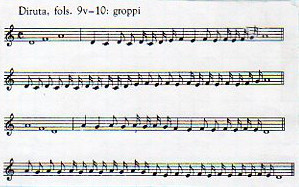

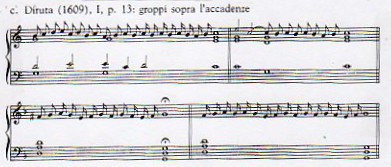
…one must intabulate with five sorts of decoration, the first we shall call Minuta [M], the second Groppi [G], the third tremoli [T], the fourth Accenti [A], & the fifth Clamationi [C] …[78]
19.113 The minuta is a running decoration, frequently based on thirds and ending on the main note:
Ex. 19.36 Diruta II, 11: Minuta sopra la parte del Soprano.
For groppi, trill with termination, see Ex. 19.35.
For the tremolo Diruta gives one example:

Ex. 19.37 Diruta, p. 13: Tremolo di Minima.
Later sources show the tremolo in combination with the trillo (Tagliavini 1983):

Ex. 19.38 a. Penna (1672), p. 152: prattica con la sinistra b. Penna, prattica con la destra:


Ex. 19.39 Gregorio Strozzi, Capricci da sonare (1687), Romanesca con partite: tremolo, trill, tirata
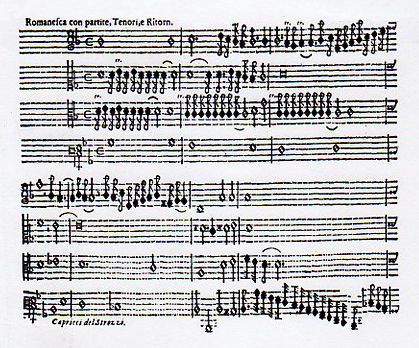
19.114 Notation of keyboard ornaments which indicates increasing number of beats and acceleration suggests a similar execution for more conventionally notated ornaments (especially cadential ones: cf. above, Ex. 19.27):
Ex. 19.40:
a. Macque, Capriccio sopra re fa mi sol, m. 60

b. Mayone (1609), Canzona francese terza, mm. 87-88

c. Mayone (1609), trills:

d. Trabaci (1603), Canzona franzesa quinta, m. 3

e. Trabaci (16156), Toccata Seconda, mm. 26-27

f. Merulo, Canzona la Zambeccara

FRESCOBALDI
19.115 Frescobaldi’s incorporation of embellishments into his keyboard style is evident in such traits as his expressive employment of ornamental figures in the Florentine tradition, his extravagant pedal-point trills, and the use of trills to sharpen rhythmic outlines. The one conventional ornamental sign that appears in his printed keyboard works is the letter “t.” As an indication of an unspecified decoration it had been employed in Italian keyboard music as early as 1576, in the Intavolatura de cimbalo of Antonio Valente. Diruta interpreted “t” as tremolo, Cavalieri as trillo: for both it denoted a trill beginning on the main note, alternating with the upper auxiliary, and occupying half the value of the principal note (see Exx. 19.22c and 19.28-19.29 above). Diruta and Praetorius, however, confirm that keyboard players also interpreted the sign as a mordent or lower-note trill.
19.116 In his two keyboard publications Giovanni Maria Trabaci employed both “t.” and “T.” (and once “tril”), apparently interchangeably. In his 1603 volume he noted: “In order not to always write out the Trill in full, where you find this letter .T. [under the note] you will always make the Trill.”[79] The context is a simple cadential formula:  . Although the T is placed under the second eighth, the realization is a cadential trill on the half note with some kind of turn, alternating with the upper auxiliary and beginning on either the main or upper note (Neapolitan practice seems to have been flexible on this point):
. Although the T is placed under the second eighth, the realization is a cadential trill on the half note with some kind of turn, alternating with the upper auxiliary and beginning on either the main or upper note (Neapolitan practice seems to have been flexible on this point):
Ex. 19.41 Trabaci:
![]()
19.117 In his 1615 collection, 41, Trabaci repeats his injunction, “In order not to always write out the Trill in full, where you find this letter .T. you will always make the Trill” but he adds “and the repeat” (“& la Riditta”), presumably referring to the turn after the trill. In this volume the trill sometimes seems a quick ornament, like Diruta’s tremoletto, placed in a cadential context:
Ex.19. 42 Trabaci 1615: trills: a p. 79: b p. 91
a)

b)

In a work for the Cimbalo Cromatico Trabaci indicates an enharmonic pitch by a double sharp with six feet and places a cross † between it and the preceding conventionally sharped pitch:[80]
Ex. 19.43 Trabaci 1615, p. 91:
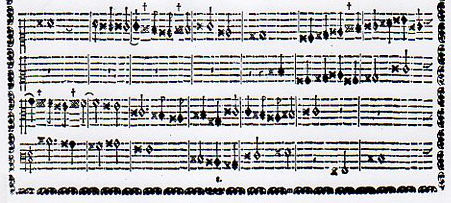
19.118 In his intabulation of Arcadelt’s “Ancidetemi pur” for harp Trabaci employs the cross in a different manner: “… at the beginning of the Tenor and Contralto in order not always to write out that kind of Trill at length, where you find this sign † you will use the said Trill.”[81] The intabulation also includes a unique ornament, a “double trill” (“t. doppio”):
Ex. 19.44 “tril. dop.”:

19.119 Sometimes such ornamental figures saturate Trabaci’s musical texture:
Ex. 19.45 Trabaci 1615, Verso quinto primo tono
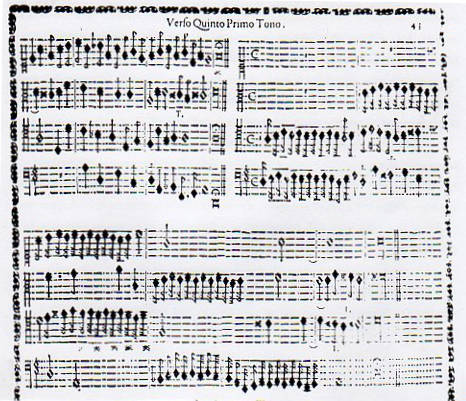
19.120 Frescobaldi employs the sign “t.”in conjunction with descending eighths and sixteenths in duple meter, placed either on (above/below) the note or between two notes. On an accented descending eighth “t.” is played as a tremoletto:  . Placed between two descending eighths it is added to the second:
. Placed between two descending eighths it is added to the second:  . (The engraving of the Toccate is sometimes imprecise so the position is uncertain, as in Toccata I/12). The “t.” also occurs between sixteenths. In the Toccata prima and Canzona seconda of book II the “t.” is added to provide rhythmic stress in passages in triple meter:
. (The engraving of the Toccate is sometimes imprecise so the position is uncertain, as in Toccata I/12). The “t.” also occurs between sixteenths. In the Toccata prima and Canzona seconda of book II the “t.” is added to provide rhythmic stress in passages in triple meter:
Ex. 19.46 Toccate II a. Toccata prima, mm. 23-30

b. Canzona seconda, mm. 24-30

19.121 Frescobaldi applies the “t.” ornament sparingly. It is absent from the Fantasie, Ricercari, and Capricci. In Toccate l it appears in Toccata 3, m. 16 and the Romanesca (1615 version), mm. 2-3. In Toccate II it is employed in Toccata l, mm. 23-29; Toccata ll, m. 1 (where it is tempting to interpret “t.” as the mordent of Diruta and Praetorius); Canzona 2a, mm. 25-27, 29, 33-34; Passacagli (1627), m. 26; La Monicha (1616), Quinta parte, mm. 1-2.
19.122 The “.t.” occurs more frequently in the Fiori musicali (caveat lector: the italic t’s are editorial interpolations), on the note between sixteenths, and generally in the pattern: __________. Tagliavini 2010, xxiii, suggests that ornaments notated in the typeset score of the Fiori musicali as a) are the equivalent of b) in the engraved scores of the toccatas and should probably be performed as c) (from a toccata of Michelangelo Rossi).
Ex. 19.47 Ornamental realizations:

Ex. 19.48 Messa delli Apostoli, trills: Toccata auanti la Messa, trills on and between notes (Tagliavini 2010)
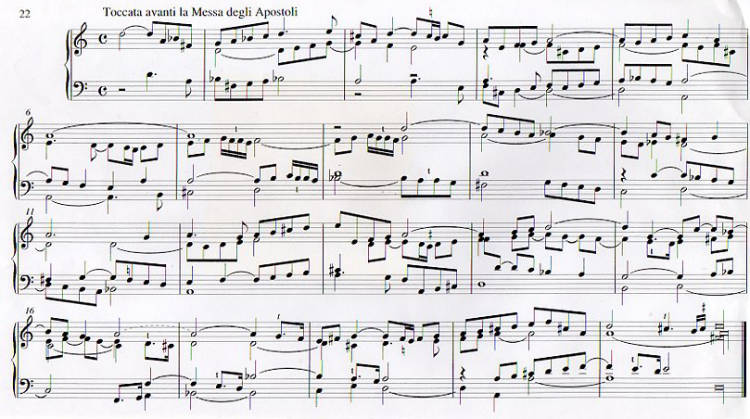
(Cf. also Canzon Dopo la Pistola, mm. 55-56, 58-60, 62-63, 65-66; Toccata Auanti Il Recercar, mm. 2, 4, 6, 11, 12.)
19.123 In addition to small localized ornaments, the Tocata per le leuatione [sic] of the Apostoli mass contains written-out ornamental figures such as cascate, tirate, and minute:
Ex. 19.49 Messa delli Apostoli, Tocata per le leuatione
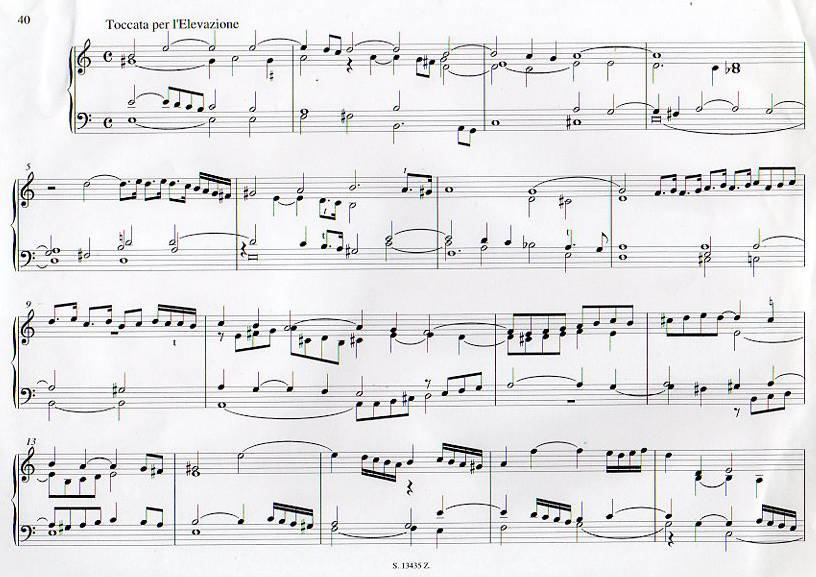

19.124 The Elevation of the Messa della Madonna is notable for expressive Lombard figuration:
Ex. 19.50 Messa Della Madonna, Tocata per le leuatione

19.125 There are cases in which Frescobaldi employs a written-out decoration as a shorthand for a more extensive one, as in the following examples, which suggest added beats and an acceleration in performance:
Ex. 19.51 Toccata I/9, mm. 1-9:
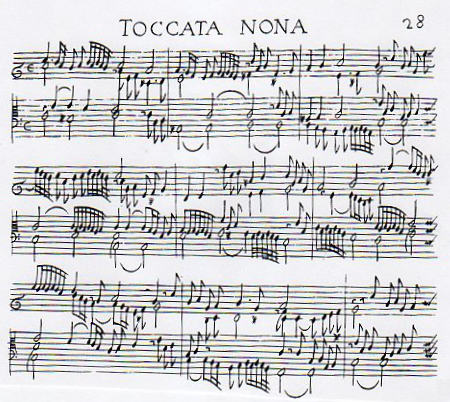
Ex. 19.52 Toccata I/6, mm. 1-4:
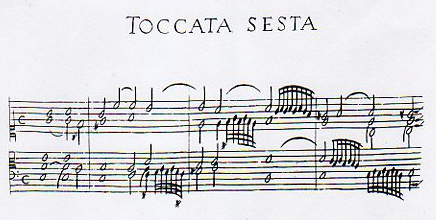
19.126 There are certain situations in which the addition of a conventional ornament, although not indicated, seems customary. Christopher Stembridge has identified a number of ways in which Frescobaldi decorated a single conventional cadential figure, and these decorations might be added in other parallel cases:
Ex. 19.53 Cadential figure and decorations (after Stembridge 2013, 112)
Turin Tablatura variants (after Stembridge 2013, 112)
Plain version in print:

Written-out versions:
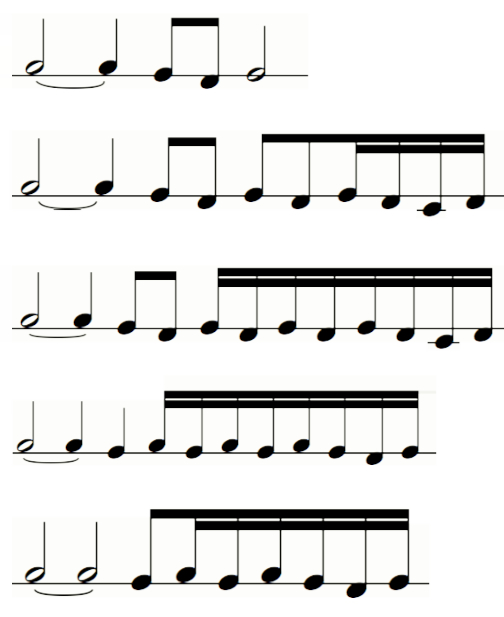
19.127 For the performer, the final message is that written-out ornaments in Frescobaldi’s keyboard music should be re-considered for a freer expressive execution rather than one slavishly following the note-picture.
The Turin manuscripts and improvised ornaments
19.128 Beyond the realization of ornamental signs and the addition of conventional ornaments in well-defined contexts there rises the question of more extensive improvised decoration. Frescobaldi himself published one written double of a harpsichord piece, the Corrente 2.a alio modo of Toccate II, a variation of the preceding Corrente prima. This is an example of what came to be called the style brisée, “broken style,” in which chords are arpeggiated (usually downward), quarters are broken into smooth eighths, and disjunct intervals are filled out into conjunct motion:
Ex.19.54 Frescobaldi: a Corrente prima b Corrente 2.a alio modo
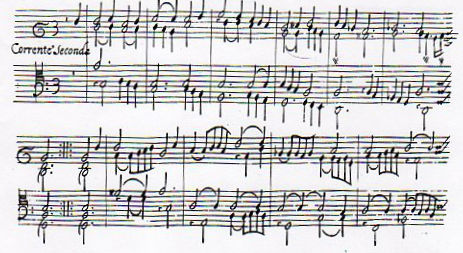
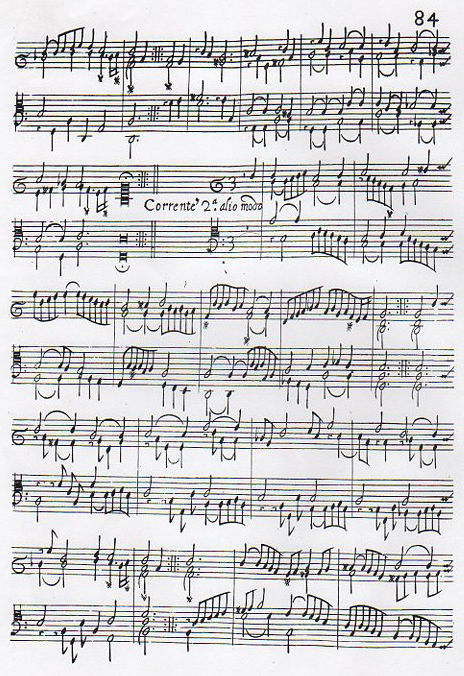

19.129 The manuscript Vatican Mus. 569 contains a Frescobaldi balletto embellished twice by a contemporary and colleague, Giovanni Battista Ferrini, who played second harpsichord with Girolamo at the Oratorio del Crocifisso. Ferrini decorates the original version of the balletto from the Aggiunta to Toccate I with a number of trills, usually underlining a rhythmic stress, and a modest cadential ornament. His written-out variation confines its embellishment to the soprano part, except where it dialogues with the bass, and employs filled intervals and afterbeats to create the generally more continuous rhythmic surface of Frescobaldi’s own Corrente seconda:
Ex. 19.55 Frescobaldi, Balletto; G. B. Ferrini, Balletto 2.º (Rome, BAV, Vat. mus. 569, fols. 18-19v):

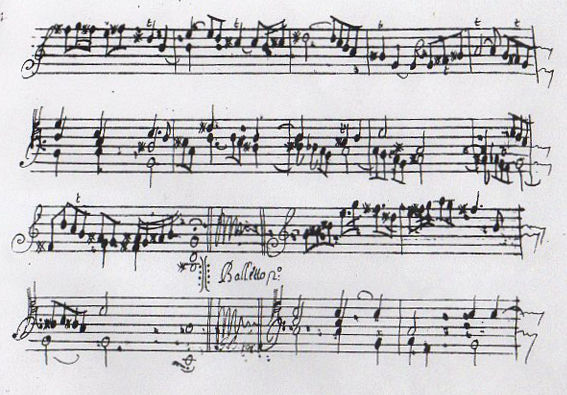
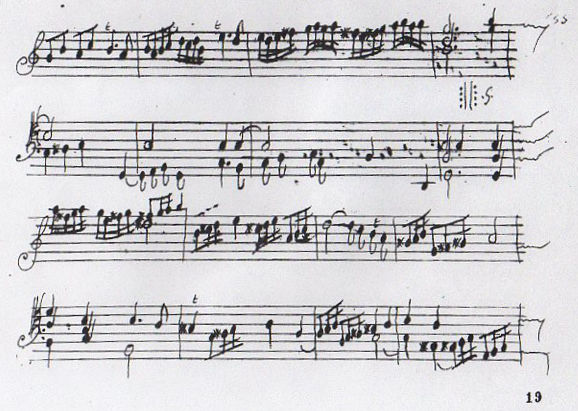
19.130 More extended decorated versions are presented in the Turin codices (Torino, Biblioteca Nazionale, Raccolte Giordano, Foà), sixteen volumes of Italian and northern keyboard music copied during the 1630s, largely from printed sources, which the scribe(s) transcribed into North German keyboard tablature. The keyboard works of Andrea and Giovanni Gabrieli and Claudio Merulo occupy a prominent position, and vol. VIII includes richly ornamented versions of the Willaert ricercari studied by Frescobaldi (see Chapter 12 above).[82] The manuscript versions of Merulo’s second book of Ricercari da cantare (1607—like the Willaert, another vocal/keyboard crossover) display a variety of ornamental solutions:
Ex. 19.56 Merulo, Ricercari II: cadential ornaments in the Turin manuscript (Felici 2005, 152-55):
a. Groppo in accadentia from upper note (trill w/ resolution)

b. Groppo in accadentia from upper note

c. Groppo in accadentia from upper note (simpler)
![]()
d. Groppo in accadentia from main note
![]()
e. Minuta or groppo: diminution between semiminims ascending by step or minims ascending by thirds

f. Groppo in accadentia filling up a falling 4th or 5th.
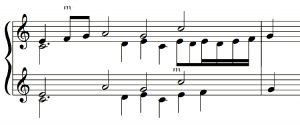
g. Tremoletto (between notes descending by step)

h. minuta e tremoletto

i. A. Bonelli, Ricercari I (1602), 3, tirata

j. groppo in accadentia (Felici 2005, 62)
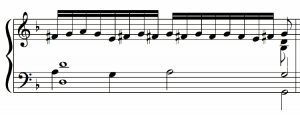
19.131 The Turin ornamentations are not complete blueprints for performance but examples of situations in which ornaments can be added, as they can be in other parallel places.
19.132 The Turin manuscripts contain almost all the contents of Frescobaldi’s Recercari et canzoni, the Capricci, both books of toccatas, and the Fiori musicali, as well as a few unpublished unica. The printed volumes were spread over volumes I, III, VI, IX, X, and XIV-XVI, sometimes capriciously divided up (e.g. the fugal sections of the toccatas were excerpted and copied separately).
19.133 The elaboration of Frescobaldi’s texts varies. The Turin version of the Toccate displays little intervention, although convincing extra bars are added at the end of the 1615 Corrente prima. In the Recercari the changes consist of a transposition down a fourth (the traditional treatment of chiavette) and the addition of a variety cadential ornaments, either written out in full or indicated by a semicircle: ˘. These have been catalogued by Stembridge (2013, 112):
Ex. 19.57 Varied cadential formulas for Frescobaldi Recercari in the Turin manuscripts (Stembridge 2013, 112):
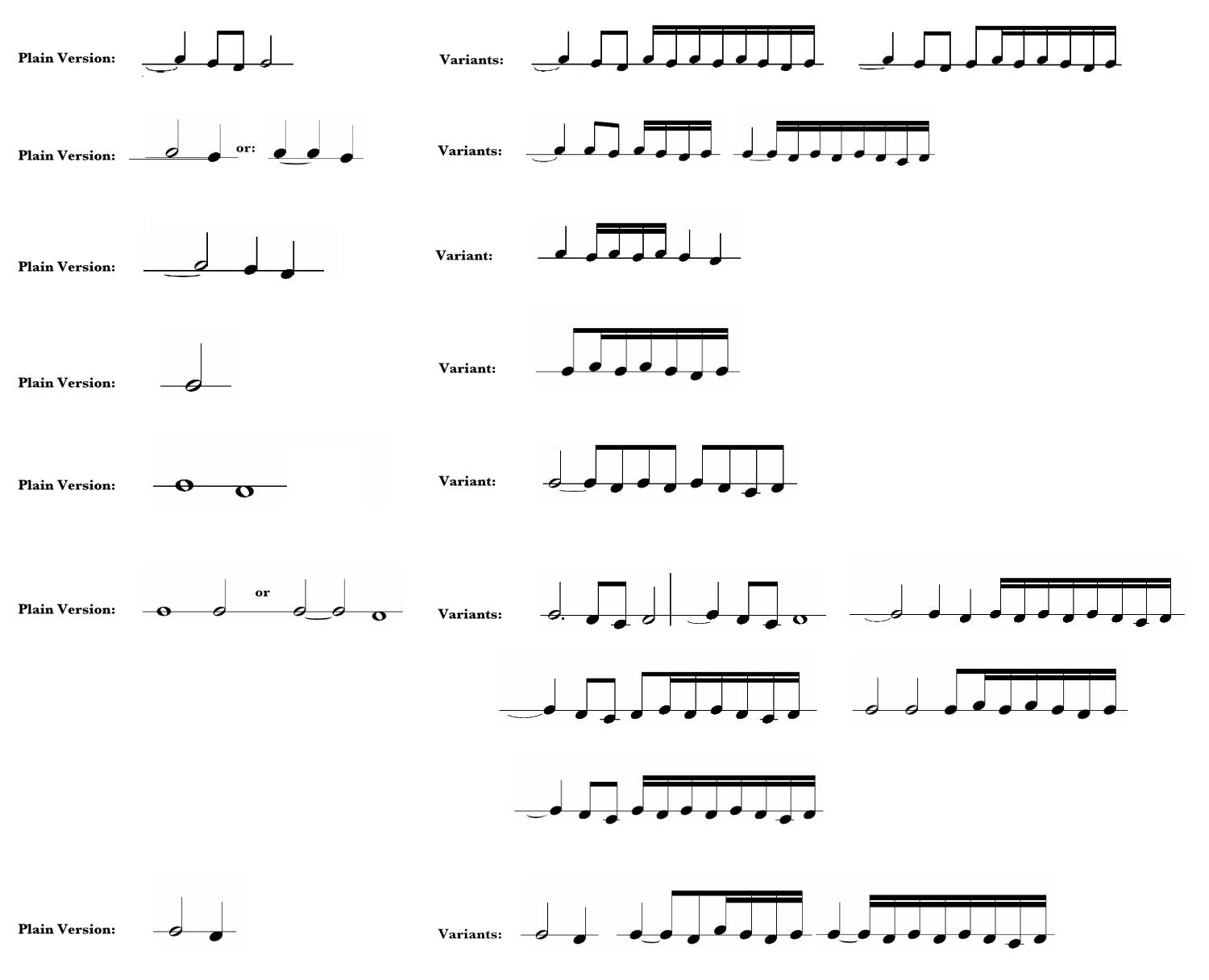
19.134 In the Turin versions of the Fiori musicali (vol. I) the ornamentation goes well beyond the addition of cadential ornaments. The added decorations in fact follow the categories of diminution given by Diruta in Il Transilvano: groppo or cadential decoration, minuta or decorated interval, and tremolo/tremoletto. A comparison of the original version with the ornaments of the Turin manuscript will show how these are applied:
Ex. 19.58 Fiori musicali, Christe della Domenica, v. 3: a original version b. Turin version
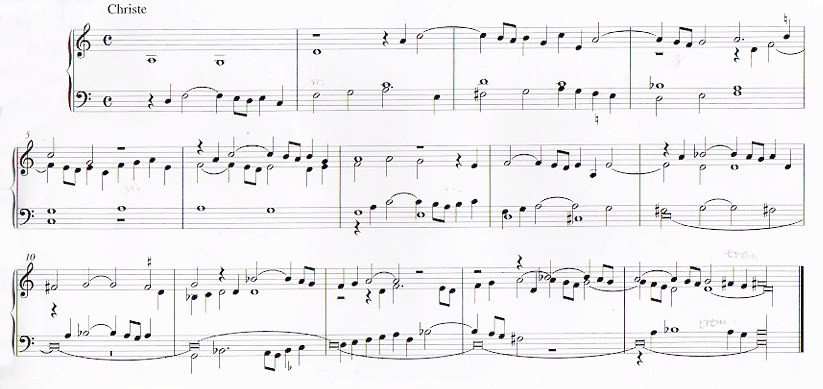
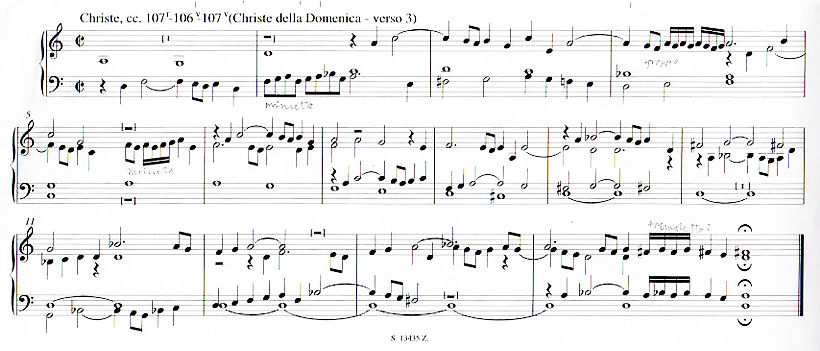
Minute are added to scalewise passages, a groppo to a cadential progression, and a tremolo at the end.
———————————————————————————————————————
19.135 The present chapter is in no sense a blueprint for the interpretation of Frescobaldi’s keyboard music; rather, it is a collection of information and observations that may enable performers to encounter Girolamo’s work sufficiently prepared to employ their own musical resources efficiently and imaginatively. After the players have tried to comprehend both physically and intellectually the musical organism confronting them, their final task—beyond any verbal or musical analysis—is to embody this understanding in a performance where, if they are fortunate, the heavenly lightning will kindle the tinder so patiently assembled, and we will experience in their pristine freshness and delight Frescobaldi’s “illogic sorceries of logic floral fire.”
FOOTNOTES

